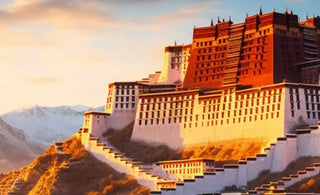
Tibetan Art: A Tapestry of Rich Heritage
Tibetan art is a profound reflection of a cultural tapestry woven with threads of spirituality, history, and tradition. This journey into Tibetan artistry unveils a landscape where each stroke, color, and form carries the weight of centuries of heritage. From Thangka paintings to intricately designed mandalas, Tibetan art stands as a testament to a rich cultural legacy.
Thangka Paintings: Windows to the Spiritual Realm
Thangka paintings, a cornerstone of Tibetan art, are intricate, hand-painted scrolls that depict Buddhist deities and scenes. These mesmerizing artworks serve not only as aesthetic masterpieces but also as spiritual tools. Thangkas are believed to have the power to aid in meditation and facilitate a deeper connection with the divine. Each stroke of the brush is a journey into the soul of Tibetan spirituality.
Mandalas: Sacred Geometry in Colorful Symmetry
In the realm of Tibetan artistic expression, mandalas stand as captivating portals to a metaphysical universe, where circular geometric patterns become a visual language communicating profound spiritual truths. Found not only in paintings but also etched into the architecture of monasteries and expressed in ephemeral sand art, mandalas encapsulate the essence of Tibetan traditions, embodying a symbolic journey through the cosmos.
At the heart of mandalas lies the concept of sacred geometry, a universal language that transcends cultural boundaries. These intricate designs, often circular in form, are meticulously crafted to represent the cosmic order of the universe. The circle, a fundamental element of mandalas, symbolizes eternity, unity, and the cyclical nature of existence in Tibetan cosmology.
In Tibetan art, mandalas are not merely ornamental; they are revered as powerful tools for spiritual practice. Often employed as aids in meditation, mandalas guide practitioners on an inner journey toward heightened consciousness. The concentric circles and geometric shapes within mandalas act as focal points, allowing individuals to delve deep into their psyche, facilitating a meditative state that transcends the ordinary.
The colors within mandalas are not arbitrary; they carry significant meaning deeply rooted in Tibetan symbolism. Each hue represents different elements, emotions, or aspects of the spiritual journey. The vibrant palette employed in mandalas is a visual feast, invoking a sensory experience that goes beyond the surface. The intricate interplay of colors mirrors the diversity and interconnectedness of all aspects of existence, reinforcing the idea of harmony and balance.
Intriguingly, sand mandalas add a temporal dimension to this ancient art form. Skilled Tibetan monks painstakingly create intricate mandalas using colored sand, only to dismantle them upon completion. This impermanence is not a sign of disregard but a profound metaphor for the transient nature of life. The act of meticulously crafting and then dismantling a sand mandala reflects the impermanence of the material world, emphasizing the importance of detachment and spiritual realization.
The practice of creating mandalas is deeply embedded in Tibetan Buddhist rituals. Monks engage in rituals known as "mandala offerings," where the mandala serves as a symbolic offering of the universe to the divine. This ritualistic expression reinforces the interconnectedness of all beings and the cyclical nature of existence in Tibetan philosophy.
Mandalas, circular geometric patterns, are another manifestation of Tibetan artistic expression. These intricate designs, often seen in architecture, paintings, and even sand art, represent the universe in its divine order. Mandalas serve as visual aids in meditation, guiding practitioners towards a higher state of consciousness. The vibrant colors and meticulous symmetry of mandalas reflect the harmonious balance sought in Tibetan traditions.
Tibetan Thangka Schools: Preserving Ancient Techniques
The creation of Thangka paintings is not a solitary endeavor; it is a skill passed down through generations within specific artistic schools. Each school has its unique style, techniques, and iconography. The preservation of these traditions is crucial, as it ensures the continuity of a distinct Tibetan aesthetic. Understanding the nuances of each Thangka school offers a glimpse into the regional diversity within Tibetan art.
Butter Sculpture: A Transient Art Form
Tibetan art extends beyond paintings and into the realm of sculpting, with butter sculpture being a unique form of artistic expression. These sculptures, often created during festive occasions, depict intricate religious symbols and deities. What makes butter sculpture distinctive is its impermanence – a metaphor for the transient nature of life. As the sculptures slowly melt, they symbolize the ephemerality of existence, a poignant reflection deeply rooted in Tibetan philosophy.
The Dance of Colors: Traditional Tibetan Festivals
Tibetan festivals are vibrant celebrations that showcase the dynamic nature of Tibetan art. The colorful costumes, masked dances, and lively music form an integral part of these festivals. The Cham dance, for example, is a sacred ritual performed by monks, featuring elaborate masks and intricate movements that tell stories of gods and demons. These festivals are not just cultural events but living canvases that bring Tibetan artistry to life.
Conclusion: A Continuum of Creativity
A journey into Tibetan artistry and traditions is a voyage through time, where creativity intertwines with spirituality. The Thangka paintings, mandalas, sculpting, and festivals collectively form a continuum of creativity, connecting the past with the present. It is a testament to the resilience of a culture that continues to express itself through art, ensuring that the echoes of Tibetan traditions resonate for generations to come.























